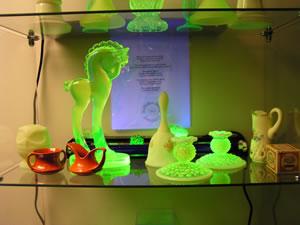TENORM: Consumer Products
Some technologically enhanced naturally occurring radioactive material (TENORM) may be found in certain consumer products. For example, zircon contains minute quantities of uranium and thorium, and is widely used as a glaze for ceramics and metal molds.
Antiques
 Among the furniture, clothing, jewelry, books, dolls, dishes, and many other objects sold at flea markets and antique shops, you will likely find items that contain radioactive compounds. These items were generally made and originally sold before the health effects of radiation were well understood and long before radiation protection regulations were put in place. "Vaseline" glass contains small amounts of uranium, which causes the glass to glow under black lights, as shown in the photo to the right. Read more about radioactive materials in antiques.
Among the furniture, clothing, jewelry, books, dolls, dishes, and many other objects sold at flea markets and antique shops, you will likely find items that contain radioactive compounds. These items were generally made and originally sold before the health effects of radiation were well understood and long before radiation protection regulations were put in place. "Vaseline" glass contains small amounts of uranium, which causes the glass to glow under black lights, as shown in the photo to the right. Read more about radioactive materials in antiques.
Building Materials
Nearly all rocks, minerals, and soil may contain small amounts of naturally occurring radioactive materials![]() naturally occurring radioactive materialsMaterials found in nature that emit ionizing radiation that have not been moved or concentrated by human activity.. These naturally occurring radioactive materials may end up in common building products such as brick, cement blocks, granite countertops, and glazed tiles. Typically found radionuclides include radium, thorium and uranium. For example, soils of the U.S. contain an average of about one picocurie
naturally occurring radioactive materialsMaterials found in nature that emit ionizing radiation that have not been moved or concentrated by human activity.. These naturally occurring radioactive materials may end up in common building products such as brick, cement blocks, granite countertops, and glazed tiles. Typically found radionuclides include radium, thorium and uranium. For example, soils of the U.S. contain an average of about one picocurie![]() picocurieThe picocurie is a U.S. unit used to measure radioactivity. One picocurie is one trillionth of a curie. of radium per gram weight, though they sometimes can contain more. When these soils or rocks are incorporated into building materials, these naturally occurring radioactive materials are included as well. Learn more about granite countertops and radiation.
picocurieThe picocurie is a U.S. unit used to measure radioactivity. One picocurie is one trillionth of a curie. of radium per gram weight, though they sometimes can contain more. When these soils or rocks are incorporated into building materials, these naturally occurring radioactive materials are included as well. Learn more about granite countertops and radiation.
Phosphate Fertilizer
The yearly consumption of phosphate based fertilizers in the U.S. averaged close to 5.8 million metric tons (MT) between 1960 and 2007 and had increased to over 8.5 million MT by 2007. Phosphate fertilizers contain some of the naturally occurring radium (Ra-226) found in phosphate ores. Read more about phosphate fertilizer.
Tobacco Products
By far, the largest radiation dose received by the public (after radon) is from smoking cigarettes. While cigarette smoke is not an obvious source of radiation exposure, it contains small amounts of radioactive materials which smokers bring into their lungs as they inhale. The radioactive particles (mostly radon progeny) lodge in lung tissue and over time contribute to a larger radiation dose. Radioactivity may be one of the key factors in lung cancer among smokers. Read more about radionuclides in tobacco smoke.
